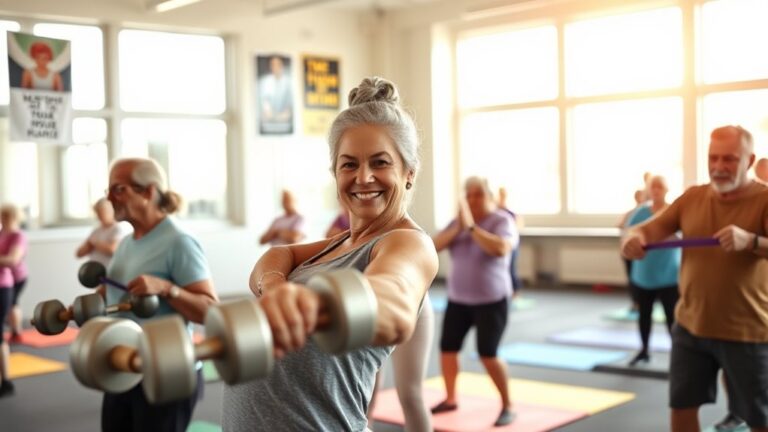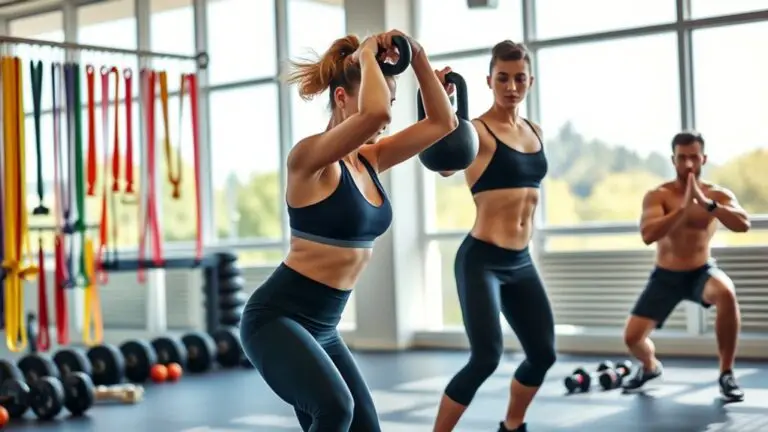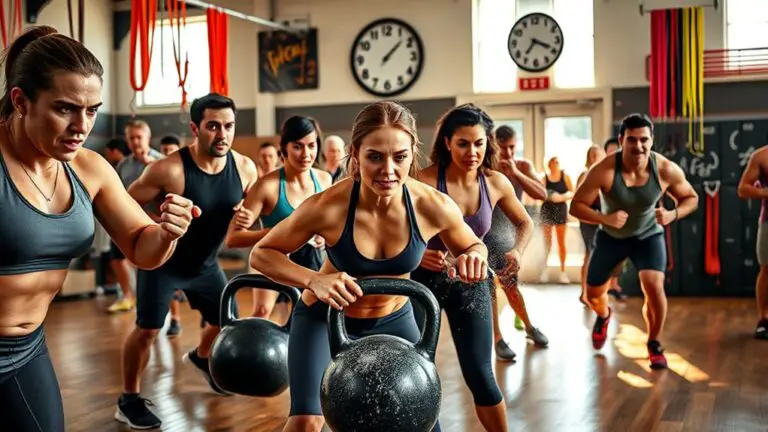The Best Low-Impact Gym Exercises for Older Adults
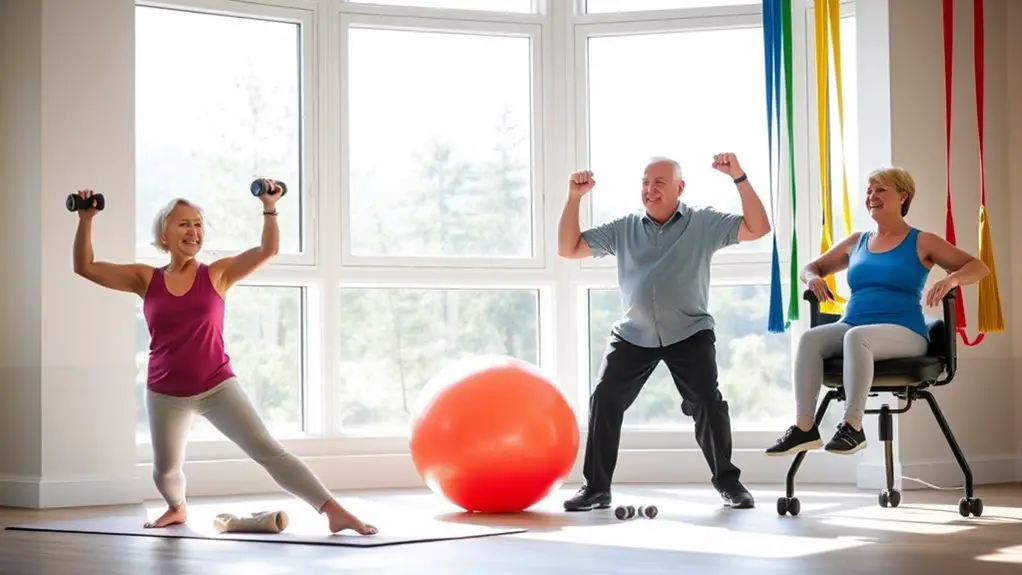
Low-impact gym exercises are perfect for older adults looking to stay fit without stressing their joints. Focus on warm-up exercises like gentle stretches and yoga poses to prepare your body. Incorporate resistance bands for strength training, and try walking workouts or aquatic aerobics for cardio. Don’t forget flexibility and balance exercises to enhance stability. Adding bodyweight exercises and stability balls can also boost your routine. Stick around to discover more ways to keep your workouts effective and enjoyable.
Benefits of Low-Impact Exercises for Older Adults
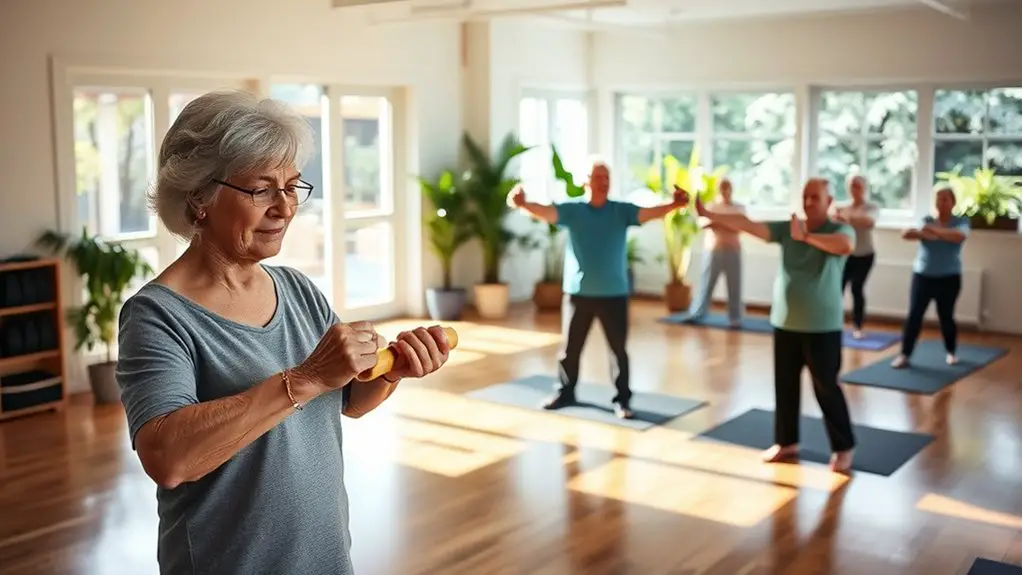
When it comes to staying active as you age, low-impact exercises offer a range of benefits that can enhance your overall well-being. These exercises are easier on your joints, making them a great option for maintaining joint health. By minimizing stress on your body, you can continue exercising without the risk of injury, which is essential as you grow older.
Low-impact workouts also contribute considerably to cardiovascular fitness. Engaging in activities like swimming, cycling, or walking can help improve your heart health, boost circulation, and increase your stamina. This means you’ll feel more energized and capable in your daily life.
Additionally, low-impact exercises can improve flexibility and balance, reducing the likelihood of falls. They promote mental well-being, too, as regular physical activity releases endorphins, lifting your mood. So, embracing low-impact exercises isn’t just good for your body; it’s beneficial for your mind.
Warm-Up Exercises to Prepare Your Body
Before you start your workout, it’s essential to warm up your body. Gentle stretching techniques can help improve your flexibility, while dynamic movement activities prepare your muscles for more intense exercises. Taking just a few minutes to warm up can make a significant difference in your overall performance and safety.
Gentle Stretching Techniques
As you prepare to engage in physical activity, gentle stretching techniques can make all the difference in warming up your body and enhancing mobility. Incorporating gentle yoga poses is a fantastic way to improve flexibility and reduce stiffness. Try simple poses like Cat-Cow or Child’s Pose, which can be easily modified for comfort. If you prefer a seated approach, chair stretches are perfect for easing tension without straining your joints. You can perform neck rolls or seated forward bends to target key areas. Remember to breathe deeply as you stretch, allowing your body to relax. These gentle methods not only prepare your muscles but also help you feel more energized and ready for your workout.
Dynamic Movement Activities
To effectively prepare your body for exercise, incorporating dynamic movement activities into your warm-up routine is essential. Dynamic stretching involves controlled movements that increase your heart rate and warm up your muscles, making them more pliable. Think of exercises like leg swings, arm circles, and walking lunges. These functional movements mimic the actions you’ll perform during your workout, helping to enhance flexibility and balance. By engaging in these activities, you’ll not only reduce the risk of injury but also improve your overall performance. Aim for 5 to 10 minutes of dynamic stretching before you engage in your workout. This way, you’ll be ready to tackle your exercises with confidence and ease, ensuring your body is primed for action.
Strength Training With Resistance Bands
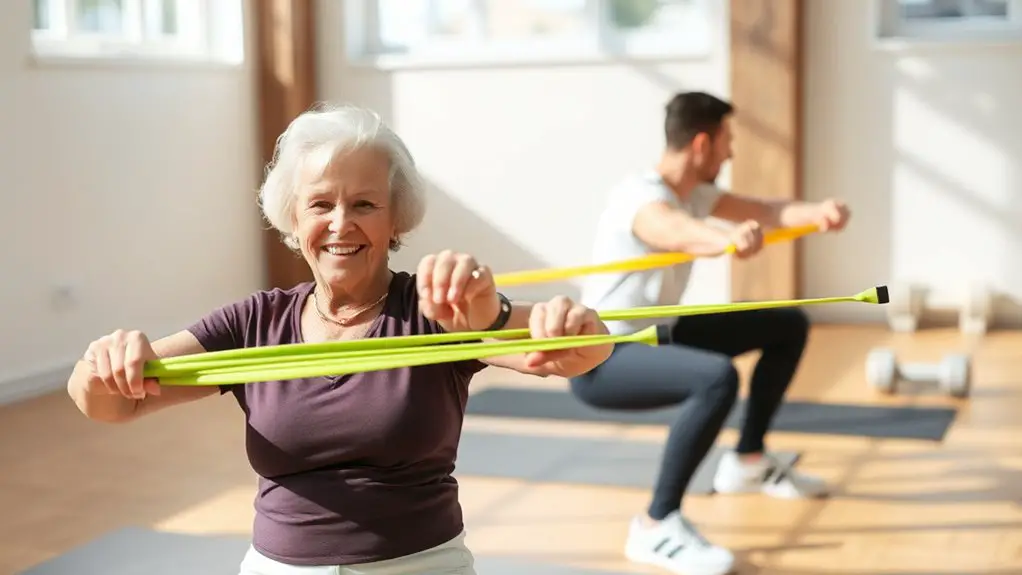
Strength training with resistance bands offers a gentle yet effective way for older adults to enhance their muscle strength and flexibility. These bands come in various resistance levels, making them perfect for tailoring your workouts to your abilities. You can perform a variety of resistance band exercises, such as seated rows, leg presses, and bicep curls, all while maintaining a low impact on your joints.
When incorporating resistance bands into your routine, it’s essential to prioritize strength training safety. Always start with a light resistance to gauge your strength and avoid injury. Make sure you’re using proper form, and consider working with a trainer if you’re unsure about the techniques. As you gain confidence, you can gradually increase the resistance. This approach helps you build strength progressively while keeping your workouts enjoyable and safe. So grab a resistance band, and start feeling the benefits today!
Low-Impact Cardio Options
Incorporating low-impact cardio options into your fitness routine can complement your strength training with resistance bands, providing a well-rounded approach to overall health. These activities are gentle on your joints while still helping to improve your cardiovascular fitness. Here are some great low-impact cardio options you can try:
- Walking workouts: Whether on a treadmill or outdoors, walking is simple yet effective.
- Aquatic aerobics: Exercising in water reduces strain on your body, making it a fantastic choice.
- Stationary biking: A great way to get your heart rate up without impact.
- Elliptical machines: They offer a smooth motion that’s easy on your joints.
- Dance classes: Fun and engaging, dance can be a joyful way to stay active.
Additionally, activities like jump rope can also provide low-impact benefits when done with proper technique, helping to strengthen muscles around the knee joints.
Flexibility and Balance Exercises
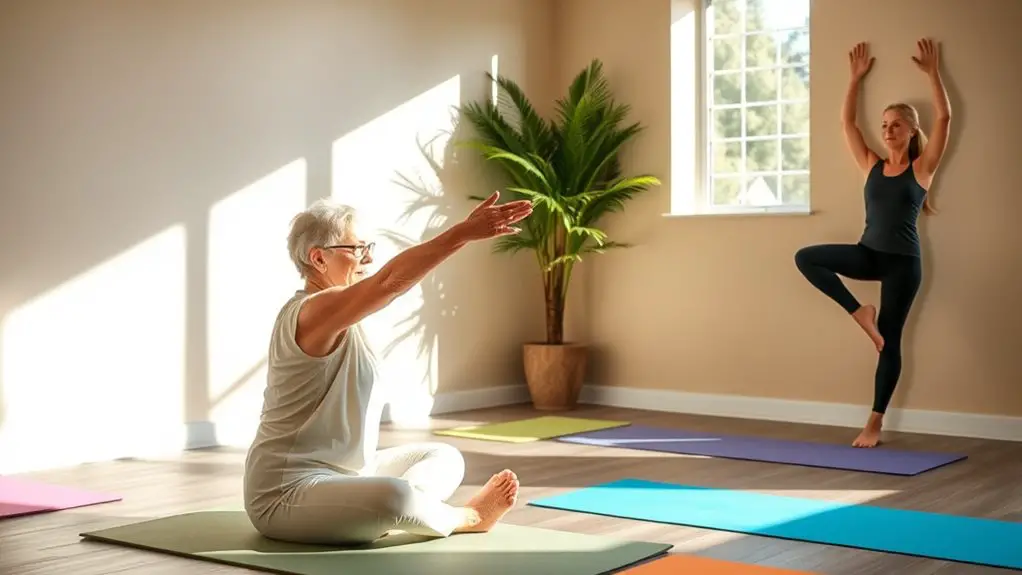
While many people focus on strength and cardio, flexibility and balance exercises are equally important, especially for older adults. Incorporating activities like yoga poses and tai chi into your routine can greatly enhance your stability and range of motion. Both practices help you improve your posture and coordination, reducing the risk of falls.
In yoga, simple poses such as Tree Pose or Cat-Cow can help stretch your muscles and promote relaxation. Tai chi, often described as “meditation in motion,” emphasizes slow, controlled movements that build strength and improve balance.
You don’t need to be an expert; start with gentle sessions and gradually increase your involvement. The key is consistency. By dedicating time to these exercises, you’ll not only feel more limber but also gain confidence in your movements. So, why not give them a try? Your body will thank you!
Bodyweight Exercises for Building Strength
After improving your flexibility and balance, it’s time to focus on building strength, which is essential for maintaining independence as you age. Bodyweight exercises are a fantastic way to enhance your strength without the need for weights. Here are some effective exercises you can try:
Building strength is crucial for maintaining independence as you age; bodyweight exercises are an excellent way to achieve this without weights.
- Bodyweight Squats: Stand with feet shoulder-width apart, lower your body as if sitting in a chair, then rise back up.
- Modified Push Ups: Perform push-ups against a wall or on your knees to reduce strain while still working your upper body.
- Lunges: Step forward with one leg, lower your hips until both knees are bent at a 90-degree angle, then switch legs.
- Seated Leg Lifts: While sitting, extend one leg out straight and hold for a few seconds before switching.
- Plank Holds: Engage your core by holding a plank position on your knees or toes for stability.
Incorporate these into your routine for better strength!
Incorporating Stability Balls Into Your Routine
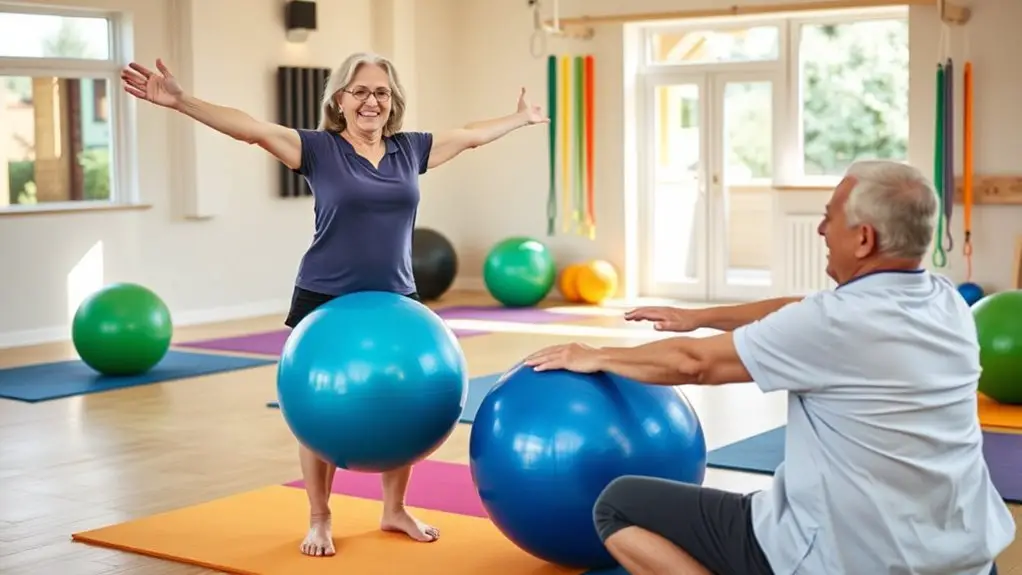
Using stability balls can add a fun twist to your workout routine, making exercises more dynamic and engaging. These versatile tools offer numerous stability ball benefits, enhancing your core strength, balance, and flexibility. Incorporating stability ball exercises into your regimen can help you develop better posture and reduce the risk of falls, which is vital as we age.
Start with simple exercises like seated marches or wall squats while resting against the ball for support. As you gain confidence, try more challenging moves like stability ball push-ups or leg lifts, which activate multiple muscle groups. Remember to keep your movements controlled to prevent injury.
A stability ball can also be an excellent option for stretching. Use it to support your back during gentle stretches, promoting relaxation while improving your range of motion. So, grab a stability ball, and enjoy the benefits it brings to your low-impact workout routine!
Tips for Staying Motivated and Consistent
Incorporating stability balls into your routine can be a fun way to keep your workouts fresh, but staying motivated and consistent is key to reaping the benefits of any exercise program. Here are some tips to help you stay on track:
- Set realistic goals: Break your fitness journey into manageable milestones to avoid feeling overwhelmed.
- Find accountability partners: Join a friend or family member in your workouts to encourage each other.
- Mix it up: Variety is essential! Try different exercises, classes, or equipment to keep things interesting.
- Track your progress: Keeping a journal or using an app can help you visualize your improvements.
- Celebrate achievements: Reward yourself for reaching goals, whether big or small, to boost your motivation.
Frequently Asked Questions
What Equipment Do I Need for Low-Impact Gym Exercises?
Think of your gym equipment as tools in a craftsman’s toolbox; each serves a purpose in shaping your fitness journey. For low-impact exercises, consider resistance bands, stability balls, and light dumbbells. These versatile tools allow for exercise modifications that keep your workouts effective yet gentle on your joints. A stationary bike or elliptical can also provide great cardio options. With the right equipment, you can sculpt your health without the strain.
How Often Should Older Adults Exercise Each Week?
When it comes to exercise frequency, older adults should aim for at least 150 minutes of moderate-intensity exercise each week. Breaking this down, you can set weekly goals of about 30 minutes a day, five days a week. This approach not only boosts overall health but also enhances mobility and strength. Remember to listen to your body, and don’t hesitate to adjust your routine based on how you’re feeling each week.
Are There Any Risks Associated With Low-Impact Exercises?
Low-impact exercises might seem safe, but they still come with risks. While they’re easier on your joints, factors like improper form or overexertion can lead to injuries. You’ve got to be mindful of your body’s signals. Prioritizing injury prevention, like warming up and using proper techniques, is vital. Balance and consistency are key, so pay attention to how you feel during and after your workouts to guarantee a safe and enjoyable experience.
Can I Exercise if I Have Chronic Pain or Injuries?
Yes, you can exercise even if you have chronic pain or injuries. It’s essential to focus on injury management and choose activities that won’t exacerbate your condition. Consider low-impact exercises, which can help maintain strength and flexibility without putting undue stress on your body. Always listen to your body, and consult with a healthcare professional to create a safe and effective exercise plan tailored to your specific needs and limitations.
How Can I Track My Progress With Low-Impact Exercises?
Did you know that tracking your progress can boost motivation by up to 30%? To effectively monitor your achievements with low-impact exercises, consider using progress metrics like time, repetitions, or distance. An exercise journal can be a great tool—jot down your workouts, feelings, and improvements. Regularly reviewing your entries will help you see how far you’ve come, making it easier to stay committed and motivated on your fitness journey.


